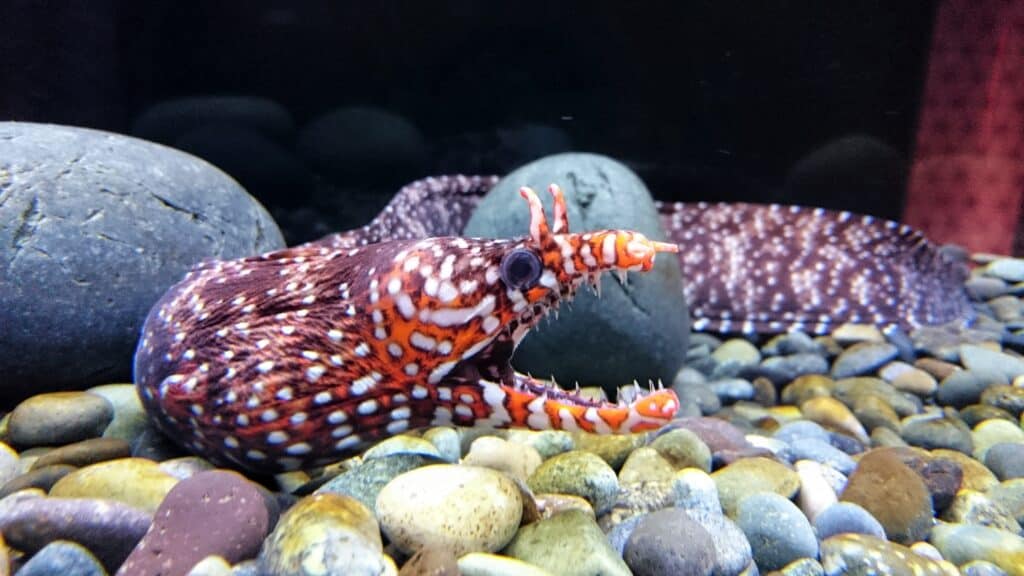Dragon Eel
Enchelycore pardalis
Dragon eels have double jaws and two sets of razor-sharp teeth
Advertisement
Dragon Eel Scientific Classification
- Kingdom
- Animalia
- Phylum
- Chordata
- Class
- Actinopterygii
- Order
- Anguilliformes
- Family
- Muraenidae
- Genus
- Enchelycore
- Scientific Name
- Enchelycore pardalis
Read our Complete Guide to Classification of Animals.
Dragon Eel Conservation Status
Dragon Eel Facts
- Prey
- Squid, shrimp, crabs, small fishes
- Main Prey
- Small fish
- Name Of Young
- elvers
- Fun Fact
- Dragon eels have double jaws and two sets of razor-sharp teeth
- Estimated Population Size
- Unknown
- Biggest Threat
- Overfishing
- Most Distinctive Feature
- Bright color patterns
- Other Name(s)
- Leopard moray eel and Tiger moray eel
- Habitat
- Indo-Pacific Ocean
- Diet
- Carnivore
- Favorite Food
- Small fish
- Common Name
- Dragon moray eel
- Number Of Species
- 200
- Location
- Indo-Pacific Ocean
View all of the Dragon Eel images!
“Dragon eels have double jaws and two sets of razor-sharp teeth.”
Dragon moray eels might look menacing, but they are actually spectacular animals. Their vibrant colors are enough to mesmerize anyone who comes across them. Their bodies are covered in orange, red, yellow, white, and black markings.
But, when you combine their large size, exposed razor-sharp teeth, and the spiked horns on their heads, it’s easy to see why many people see them as terrifying.
Their preferred habitat is coral reefs and rocky outcrops in the Indo-Pacific , all the way to Hawaii and southern Japan.
These eels scale the sea bed and use rocky formations for hunting and a safe place to hide. In addition, dragon eels have an excellent sense of smell that helps them identify prey in the dark crevices of the ocean floor.
Amazing Facts About Dragon Eels
- Dragon eels have double jaws and two sets of razor-sharp teeth
- Dragon eels have an excellent sense of smell to make up for their poor eyesight
- Dragon eels pursue “cleaner shrimp,” not to eat them but for a thorough cleaning
- 200 species of moray eels inhabit the world
- Moray eels are scaleless; instead, they protect their bodies with a slippery mucus, and depending on the species, it is toxic
Classification and Scientific Name
Dragon eels’ scientific name is Enchelycre pardalis, and they belong to the class Actinopterygii. Antino stands for ‘having rays.’ Its members are ray-finned fishes, like most bony fish.
In addition, Dragon eels belong to the family Muraenidae whose members are distributed all over the world.
While the majority of 200 species belonging to this family are sea-dwelling creatures, several others inhabit brackish water and fresh water.
At present, no subspecies have been identified.
Other Types of Moray Eels
- Allardice’s Moray
- Hardtail Moray
- Seychelles Moray
- Chain Moray
- Fangtooth Moray
- Mosaic Moray
- Viper Moray
- Zebra Moray
- Narrowtail Moray
- Laced Moray
Dragon Eel Population and Conservation Status
Dragon eels are listed as Least Concern on IUCN’s Redlist. Even though their numbers are good, Hawaii still has regulations in place to monitor harvest levels. In addition, several of their habitats overlap multiple Marine Protected Areas.
How to Identify Dragon Eels: Appearance and Description
Dragon moray eels are muscular and have long bodies with a flattened tail that looks similar to an oar. In addition, their dorsal fin is long and runs from their head all the way down their bodies until it fuses with their tail fins.
They generally have a long snout with large eyes and mouths. Dragon eels have tiny teeth, but they are razor-sharp.
Dragon eels lack pectoral and pelvic fins, unlike other fish species, and come in a variety of colors, including:
- Yellow
- Green
- Black
- Brown
- Gray
- Blue
- Orange
- White
In addition, their bodies are covered in complex spotted, stiped, or blotched patterns, with a pale underbelly that helps them camouflage from predators. Generally, dragon eels measure 3 feet in length.

Dragon eels are highly sought after by aquarists due to their unusual appearance, brilliant colors, and patterns.
©chonlasub woravichan/Shutterstock.com
Predators and Threats
Dragon moray eels don’t have a lot of predators. Depending on their ecosystems, they are usually preyed upon by apex predators like the:
But, interestingly, groupers and moray eels sometimes work side-by-side when hunting. To signal the moray eel, the grouper will shake its head vigorously, letting the eel know it wants to work together.
They do this by swimming together and trapping the fish. The moray eel doesn’t dare to escape; otherwise, it gets eaten by the grouper.
Dragon eels are considered a delicacy in some countries, so they are commercially fished. However, they have toxins in their skin, which can be fatal if not prepared correctly. Luckily, there is no cause for alarm yet, but Dragon eels are essential to their ecosystem. If their population is disrupted, it could badly affect other marine animals and coral reefs.
Dragon Eels Diet
Dragon moray eels are carnivores and are primarily nocturnal, which means they are active at night. Their main prey is smaller crustaceans and fish.
Unfortunately, they have really poor eyesight, but make up for it with their excellent sense of smell. In order to take on larger prey, Dragon eels knot their bodies to gain leverage.
Their second set of jaws are called pharyngeal jaws, and they house the second set of teeth. Their first set of teeth latches onto the prey. Next, they move their pharyngeal jaws forward to hook the prey and pull it further into the throat and eventually the stomach.
Moray eels are the only fish species to use a second set of jaws to capture their prey. Because they have to rely on their scent to capture prey, Moray eel’s usually hunt weak or dead creatures.
Reproduction and Lifespan
Some species of Moray eels are hermaphrodites, and they switch from their inborn sex to the opposite sex. However, others are synchronous, which means they only reproduce once in a lifetime and can reproduce with either sex.
Their mating season occurs when the water temperature increases. During the mating ritual, they wrap their bodies around each other and release sperm and eggs simultaneously.
After the eggs hatch, they float around for 8 months before developing into elvers and eventually an eel.
Dragon Eels in Fishing and Cooking
Dragon eels are commercially fished, and some cultures do eat them. However, their skin is toxic and could be fatal if not prepared properly.
While they are not endangered, they are vulnerable to over fishing, which can severely disrupt their ecosystem and all the marine animals who share it with them.
Dragon Eels in Aquariums
Dragon eels are kept in aquariums, but there are strict instructions one must follow to keep them alive. Firstly, the aquarium must be able to hold 180 gallons of water and contain an abundance of well-secured rocky crevices and caves.
In addition, these hideaways need to be big enough to house an adult Dragon eel up to 3 feet in length. Eels are escape artists, so the aquarium needs to have a secure lid; they are powerful with their muscular bodies and can easily push the top off, so be sure it’s not flimsy.
Tank Size
The tank needs to accommodate 180 gallons of water. However, Dragon eels don’t swim a lot, but the aquarium should be at least 2 feet. The length is important for all the caves and crevices that must occupy the tank.
Coral reefs won’t harm a Dragon eel if eaten but proceed cautiously as the eels are so big that they can easily destroy the reefs.
In addition, Dragon eels will hunt and eat several helper invertebrates like crabs and shrimps, often found in reef aquariums, and act as a cleaning crew. Unfortunately, they also eat smaller fish, so having a Dragon eel in a reef aquarium is not a good idea.
Tank Friends
Dragon eels are very aggressive and will consume almost anything that can fit into its mouth. That’s why it’s best to purchase larger predatory fish that won’t be threatened by the eel.
However, it’s common to house fully-grown Dragon eels in a species-only aquarium because of their feeding habits and aggressive nature.
If the tank is greater than 200 gallons, the following species will work well with the Dragon Moray eel:
The Japanese Dragon moray eel is one of the most sought-after eels for an aquarium. However, they don’t come cheap, and you can expect to fork out $1,000 or more to obtain one.
Dragon Eel
View all 110 animals that start with DDragon Eel FAQs (Frequently Asked Questions)
Are dragon moray eels poisonous?
Dragon eels are considered a delicacy in some countries, so they are commercially fished. However, they have toxins in their skin, which can be fatal if not prepared correctly
How big do dragon moray eels get?
Generally, Dragon eels measure 3 feet in length.
How long do dragon moray eels live?
Dragon eels can live up to 10 years old.
What fish can live with moray eels?
If the tank is greater than 200 gallons, the following species will work well with the Dragon Moray eel:triggers, groupers, snappers, puffers, and lionfish.
Thank you for reading! Have some feedback for us? Contact the AZ Animals editorial team.
Sources
- Seaunseen / Accessed July 30, 2022
- Aquarium Domain / Accessed July 30, 2022
- Waikiki Aquarium / Accessed July 30, 2022
- Wikipedia / Accessed July 30, 2022


















